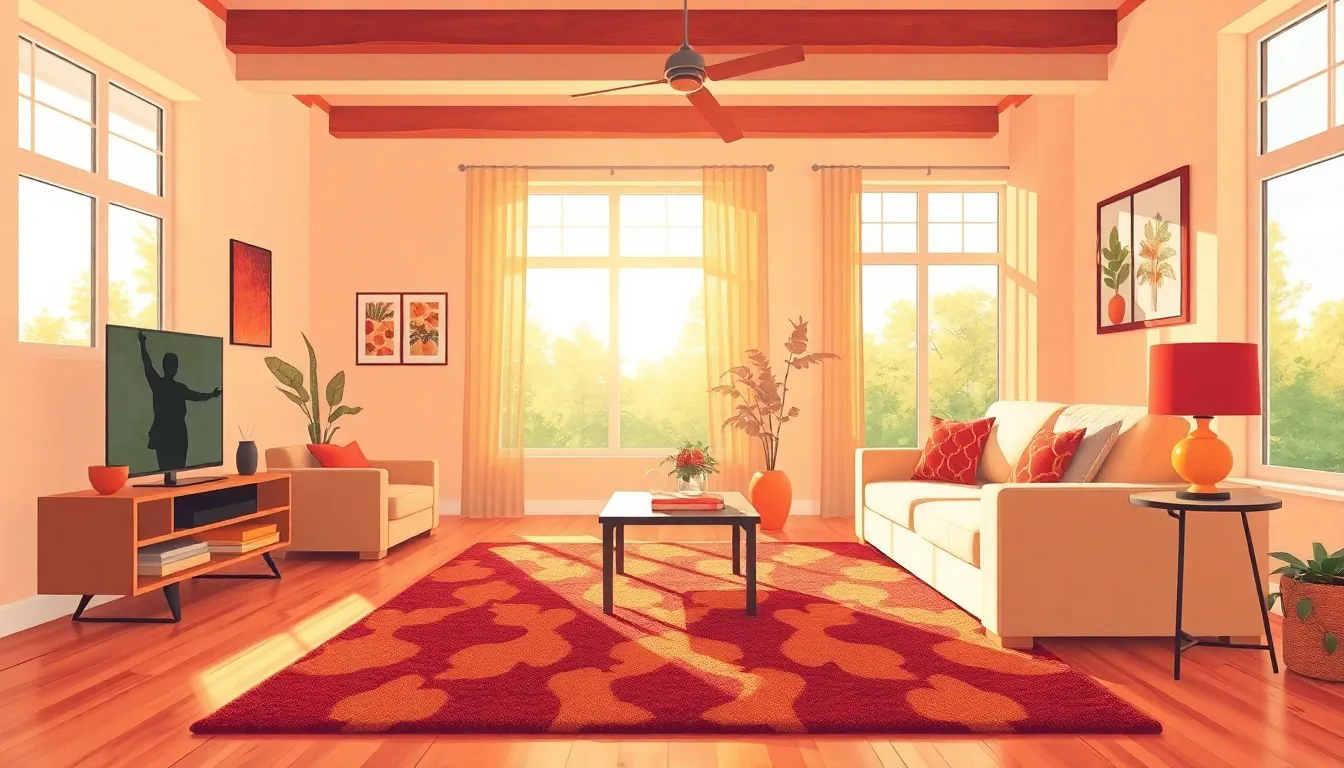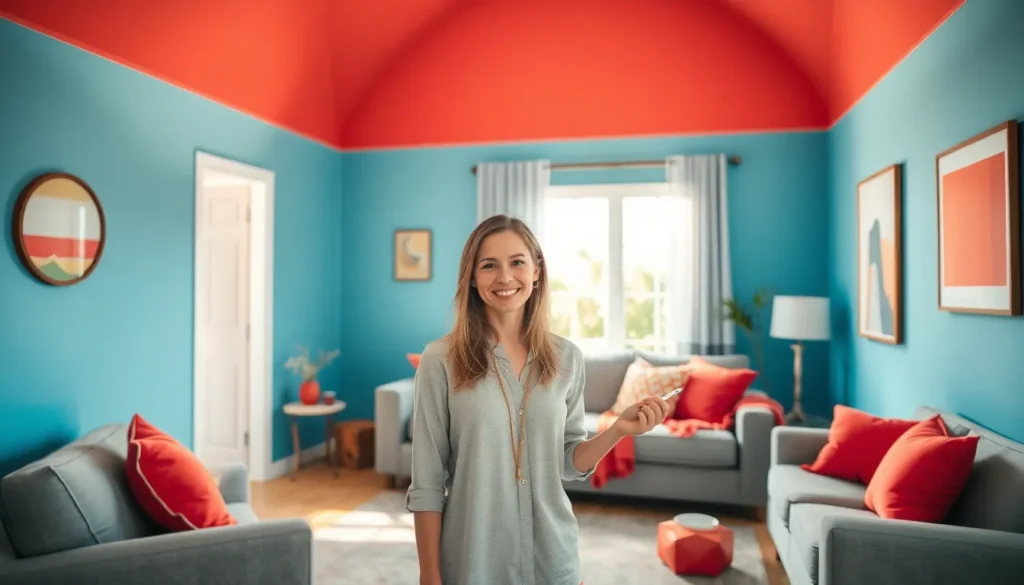Ever walked into a room and felt an instant mood shift? That’s no accident. Color psychology plays a sneaky but powerful role in how we feel in our homes. From calming blues that whisper relaxation to fiery reds that scream energy, the colors on your walls can transform your space—and your state of mind.
Table of Contents
ToggleUnderstanding Color Psychology in Homes
Color psychology plays a crucial role in shaping emotions and experiences within home environments. Choosing the right colors affects mood, wellbeing, and even behavior.
The Basics of Color Psychology
Color influences feelings directly. Each hue carries distinct emotional associations. For example, blue often evokes calm, while yellow can inspire happiness. Green connects people with nature, promoting tranquility. In contrast, red stirs excitement and passion. Understanding these associations allows for thoughtful choices in home decor. Homeowners can create atmospheres that align with desired emotional states by selecting appropriate colors.
Importance of Color in Interior Design
Color constitutes a fundamental element of interior design. It influences not just aesthetics but also functionality and atmosphere. Cooler colors can enhance a room’s perceived space, making it feel larger and more open. Warmer colors, on the other hand, create intimacy in smaller areas. Equally, color schemes can define zones within an open layout, guiding flow and purpose. Thoughtfully applied colors lead to more engaging spaces that foster comfort and creativity. Designers leverage these principles to tailor environments that meet specific needs and preferences.
Color Schemes and Their Effects

Different color schemes significantly influence emotions and perceptions within a home. Colors are more than mere decoration; they can transform the ambiance and overall feel of a space.
Warm Colors and Their Impact
Warm colors such as red, orange, and yellow evoke feelings of warmth and energy. They stimulate conversation and can make spaces feel cozy and inviting. Red conveys excitement and passion, making it suitable for active areas like kitchens or living rooms. Orange, with its cheerful aura, promotes creativity and enthusiasm, ideal for playrooms or offices. Yellow brightens spaces and fosters happiness, making it perfect for areas where one seeks positivity. Using these colors in moderation can create dynamic environments without overwhelming occupants.
Cool Colors and Their Influence
Cool colors like blue, green, and purple instill a sense of calm and tranquility. Blue, known for its soothing properties, benefits bedrooms or bathrooms, promoting relaxation. Green connects individuals with nature, enhancing feelings of balance, making it suitable for living rooms or dining areas. Light purple imparts a peaceful atmosphere, often used in spaces dedicated to rest or meditation. These colors can also visually expand smaller areas, contributing to a more spacious feeling. Thoughtful incorporation of cool tones facilitates a serene home environment.
Choosing Colors for Different Rooms
Different rooms in a home serve distinct purposes, and color choices can greatly influence their atmosphere.
Living Room Color Choices
Neutral tones like beige and gray create a versatile backdrop, allowing flexibility in decorating. These shades promote a welcoming environment. Vibrant colors such as teal or coral stimulate conversation, fostering interaction among guests. Darker hues like navy or forest green add depth, providing a cozy feel for family gatherings. Selecting colors based on desired activities within the living room can significantly enhance the space.
Bedroom Color Options
Soft, muted colors like lavender and soft blue promote relaxation, making them ideal for restful atmospheres. White or light gray enhances a sense of spaciousness, contributing to peaceful sleep. Warm earth tones, including taupe and soft brown, generate comfort and warmth. Adding personal touches through accent colors can deepen emotional connections to the space. Choosing colors that reflect individual preferences supports an overall sense of well-being in the bedroom.
Kitchen and Dining Area Colors
Bright white or creamy shades can increase brightness, making the kitchen feel clean and spacious. Incorporating warm tones, such as yellow or soft orange, contributes to a cheerful atmosphere, encouraging social interaction during meals. Cool greens or blues create a refreshing environment, making food preparation more pleasant. Selecting colors that resonate with the household’s cooking style can enhance the kitchen’s appeal. Thoughtful choices in dining areas can promote appetite and enjoyment during meals.
The Role of Light in Color Perception
Light plays a crucial role in how colors are perceived within a space. Variations in lighting can dramatically alter the appearance of hues throughout the day.
Natural Light and Color Dynamics
Natural light varies by time of day and season, influencing color perception in significant ways. Morning light renders colors cooler, while late afternoon light casts a warm glow that enhances warmer shades. Sunlight also reveals the true nature of colors, highlighting undertones that artificial lighting may obscure. Rooms with ample natural light often feel more vibrant, making colors appear more saturated and lively. Such lighting can create a cohesive and inviting atmosphere, enhancing the overall emotional experience within a home.
Artificial Lighting Effects
Artificial lighting affects color perception in various ways, including color temperature and brightness. Warm white bulbs enhance reds and yellows, creating cozy environments, while cool white and daylight bulbs emphasize blues and greens, adding a fresh, modern touch. Different types of artificial lighting can transform the feel of a color instantly. For example, fluorescents can wash out colors, while incandescent lights make them appear richer. Homeowners should consider these effects when selecting fixtures to ensure colors align with their desired moods in each space.
Tips for Implementing Color Psychology
Select colors that reflect personal preference for each room’s atmosphere. Choosing calming shades of blue in a bedroom encourages relaxation and tranquility. Vibrant hues like red or orange in a living room can spark lively conversations and foster energy. Incorporate earthy tones such as greens and browns in kitchens to inspire an inviting and refreshing ambiance.
Consider the size and lighting of a space when deciding on colors. Small rooms benefit from light shades to create an illusion of openness, while larger areas may embrace darker colors for intimacy. Using mixed lighting can also impact how colors appear; natural light presents colors differently than artificial ones, highlighting their vibrancy.
Develop a cohesive color scheme throughout the home. Transitioning from room to room with complementary colors offers a sense of harmony. For instance, pairing warm reds in a dining area with cool greens in an adjacent living room maintains balance while expressing distinct moods.
Test paint samples in various lighting conditions. Viewing swatches during different times of the day reveals how color perception alters based on natural light. It’s also beneficial to observe how artificial lighting changes hues, ensuring that the desired atmosphere aligns with the lighting setup.
Prioritize specific color meanings when selecting shades. Soft pastels facilitate calmness, while bright colors enhance creativity and joy. Understanding the emotional implications of color supports intentional design choices, promoting overall well-being in the home environment.
Seek inspiration from nature as well. Including colors found outdoors, like sky blues or grass greens, can foster a sense of connection and serenity within the home. Thoughtful implementation of color psychology can transform any space into an emotionally supportive haven.
Understanding color psychology is essential for creating harmonious and emotionally supportive spaces in the home. The colors chosen can significantly influence mood and atmosphere, making it crucial to select hues that align with personal preferences and the intended purpose of each room.
By incorporating thoughtful color schemes and considering the effects of natural and artificial lighting, homeowners can enhance both the aesthetic appeal and emotional well-being of their environments. Ultimately, the right colors can transform a house into a sanctuary that fosters comfort, creativity, and connection, enriching everyday life.









